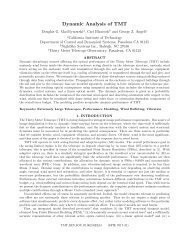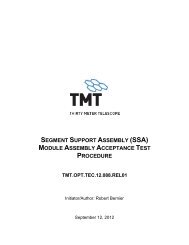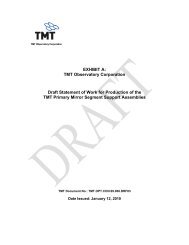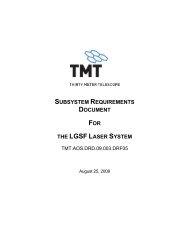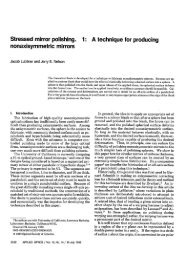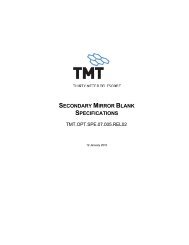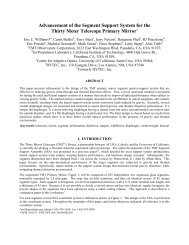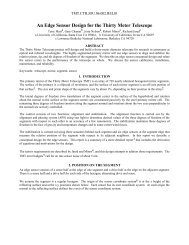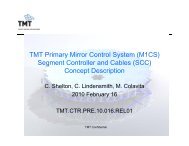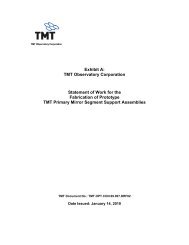TMT Construction Proposal - Thirty Meter Telescope
TMT Construction Proposal - Thirty Meter Telescope
TMT Construction Proposal - Thirty Meter Telescope
Create successful ePaper yourself
Turn your PDF publications into a flip-book with our unique Google optimized e-Paper software.
2.10 Our Solar System<br />
Our own Solar System is the planetary system that we can study in the<br />
most detail, and provides a reference for studies of exoplanets. <strong>TMT</strong> will<br />
contribute greatly to our knowledge, particularly of the planets, satellites,<br />
and small bodies of the outer Solar system.<br />
2.10.1 The outer Solar System<br />
Large populations of small bodies orbit beyond the major planets. These<br />
are relics left over from the formation of the Solar System. By studying<br />
their dynamical properties and compositions we can learn much about the<br />
physical processes by which our planetary system formed. These trans-<br />
Neptunian objects are small and extremely faint. Only the largest<br />
members, with size comparable to that of Pluto, have been detected. With<br />
adaptive optics,<br />
<strong>TMT</strong> will be able to detect objects with diameters as small as 1 km in the<br />
Kuiper belt, beyond Neptune’s orbit, in only 15 minutes exposure time.<br />
2.10.2 Imaging the outer planets and their satellites<br />
Fig 2-23: Image of Europa at<br />
the resolution of <strong>TMT</strong> + IRIS.<br />
Cracks in the icy crust, craters<br />
and surface features are<br />
clearly visible (M. Brown, CIT).<br />
With adaptive optics, <strong>TMT</strong> will have a resolution of 7 milliarcsec at a<br />
wavelength of 1 um. This corresponds to 25 km at the distance of Jupiter,<br />
sufficient to resolve features on the surfaces of the moons of the outer planets. With <strong>TMT</strong> + IRIS it will be<br />
possible to obtain spatially-resolved spectra to study the atmospheric and surface chemistry, and monitor these<br />
objects regularly and detect changes due to weather, vulcanism and tectonic activity.<br />
2.10.3 Atmospheric physics of the outer planets and satellites<br />
High-resolution mid-infrared spectroscopy can reveal the composition of the atmospheres of the outer planets<br />
and their satellites in great detail. By combining this with physical modeling, one can study the complex<br />
chemical and photochemical reactions that produce the diversity of inorganic and organic molecules. <strong>TMT</strong> will<br />
be able to study the atmospheres of all planets and satellites in the Solar System with much higher spectral<br />
resolution than any space probe that has visited these objects.<br />
Fig 2-24: High-resolution spectrum of Titan obtained with the Texes<br />
mid-infrared spectrometer, illustrating how high-resolution<br />
observations can give detailed information about the abundances of<br />
molecular species (Roe et al. 2003).<br />
<strong>TMT</strong> <strong>Construction</strong> <strong>Proposal</strong> 18



